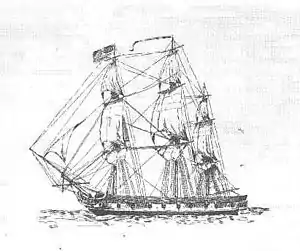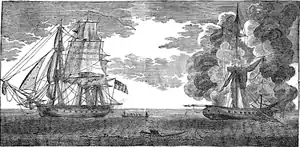USS Wasp (1814)
USS Wasp was a sloop-of-war that served in the United States Navy in 1814 during the War of 1812. She was the fifth United States Navy ship to carry that name. She carried out two successful raiding voyages against British trade during the summer of 1814, in the course of which she fought and defeated three British warships. Wasp was lost, cause unknown, in the Atlantic in early autumn, 1814.
 USS Wasp | |
| History | |
|---|---|
| Name | USS Wasp |
| Namesake | Wasp |
| Builder | Cross & Merrill, Newburyport, Massachusetts |
| Launched | September 18, 1813 |
| Commissioned | February 1814 |
| Fate | Disappeared October 1814 |
| General characteristics | |
| Type | Sloop-of-war |
| Tonnage | 509 |
| Length | 117 ft 0 in (35.66 m) |
| Beam | 31 ft 6 in (9.60 m) |
| Draft | 14 ft 6 in (4.42 m) |
| Sail plan | Ship-rigged |
| Complement | 173 officers and enlisted men |
| Armament |
|
Service history
Wasp was a ship-rigged sloop-of-war constructed in 1813 at Newburyport, Massachusetts, by Cross & Merrill. She was commissioned in February of 1814, with Master Commandant Johnston Blakeley in command. She remained at Portsmouth, New Hampshire, until late spring awaiting sailing orders and, upon receipt of them, put to sea on 1 May 1814 for a war cruise to the western approaches to the English Channel.
First raiding voyage
Wasp captured her first vessel, the 207-ton barque Neptune, on 2 June 1814, embarked her crew as prisoners, and burned the prize at sea. On 13 June 1814, she took William, a 91-ton brig, and burned her as well. Wasp encountered the 131-ton armed brig Pallas on 18 June 1814, captured her, apparently without resistance, and scuttled her. Her fourth victim, 171-ton galiot Henrietta, which she took on 23 June 1814, was given up to the prisoners Wasp had thus far taken. On 26 June 1814, Wasp captured and scuttled the 325-ton ship Orange Boven.
Sinking of HMS Reindeer


On 28 June 1814, Wasp came upon the 18-gun Cruizer-class brig-sloop HMS Reindeer some 225 miles west of Plymouth, England, and brought her to battle. The fight lasted only 19 minutes, but during that brief span of time the two ships traded a murderous fire of grape and solid shot. Several times, Reindeer's crew tried to board Wasp, but the American crew repulsed them on each occasion. In the end, Wasp's own ship's company boarded Reindeer and captured the ship. Wasp suffered six hits in her hull, and some of her rigging was shot away, but she remained capable of sailing. Reindeer had suffered 25 men killed, including her captain, Commander William Manners, and 42 wounded.[1]

After taking prisoners on board, setting fire to Reindeer, and watching her explode, Wasp set course for Lorient, France. En route, she took two more prizes, the 112-ton brig Regulator on 4 July 1814 and the 151-ton schooner Jenny on 6 July 1814. Jenny had been sailing from Leghorn to St Petersburg when Wasp captured her. On 7 July another vessel came across Jenny and reported that her masts were cut away and she was full of water. Not long thereafter, Wasp entered Lorient for repairs, provisions, and care for her wounded. Wasp brought Jenny's crew with her and put them on a cartel for Britain.[2]
Second raiding voyage
Wasp remained in Lorient until she again put to sea on 27 August 1814. On 30 August 1814, she captured the brig Lettice and, on 31 August 1814, took another, Bon Accord. Early in the morning of 1 September 1814, she encountered a convoy of 10 ships escorted by the 74-gun ship-of-the-line HMS Armada. Wasp made for the convoy and singled out the brig Mary, which she quickly took as a prize, carrying off Mary's crew as prisoners and burning her. The American sloop then attempted to take another ship in the convoy, but Armada chased her off.
Sinking of HMS Avon

That evening, she spied another sail on the horizon and gave chase. By 2130, she had the brig under her lee bow and opened fire. The enemy returned fire until 2200 at which time her battery seemed to cease fire. When Wasp did the same and called for the stranger's surrender, the British ship answered with another cannonade. Wasp again opened fire on the ship, now known to have been the 18-gun, 391-ton brig HMS Avon. Some broadsides later, Avon's guns fell silent once more, and Wasp repeated the call for surrender. Avon, at this point a battered hulk, had no choice but to comply.
However, just as Wasp began to lower the boat for the prize crew, the lookout sighted another enemy brig standing toward the two adversaries. Wasp's crew manned their battle stations immediately in hope of taking the newcomer as well. Just then, two more British ships appeared on the horizon and Wasp was forced to give up the destruction of Avon and see to her own salvation. The lead British ship, however, failed to engage Wasp; instead, she hauled in close to Wasp's stern and loosed a broadside into the American's rigging which damaged sails, sheets, and braces considerably and then came about to rendezvous with the other two ships following her and the sinking Avon. Although the Americans did not know it at the time, Avon sank soon after Wasp left her. Avon had suffered 10 killed and 32 wounded.[1] Avon's primary rescuer was her sister ship, Castilian.[1]
The American warship continued her ravages of the British merchant marine. On 12 September 1814, she encountered Three Brothers, a brig, and scuttled her. On 14 September 1814, she sank the brig Bacchus. On 21 September 1814, an eight-gun brig, Atalanta (or Atlanta), ran afoul of Wasp, and she, too, suffered the ignominy of capture. Deeming Atalanta too valuable to destroy, Blakeley placed her under the command of Midshipman David Geisinger and sent her to the United States. She entered Savannah, Georgia safely on 4 November 1814.
Fate
After Wasp and Atalanta parted company, on 9 October 1814 she spoke the Swedish brig Adonis, bound from Rio de Janeiro to Falmouth, England, about three weeks after the Atalanta capture. Wasp reported that she was headed for the Caribbean.[3] Wasp probably foundered in a storm.
Tables
First raiding cruise
| Date | Ship name | Burthen | Ship Type | Location | Disposition of ship |
|---|---|---|---|---|---|
| 2 June 1814 | Neptune | 207 | Barque | English Channel | Burned |
| 13 | William | 91 | Brig | " | Burned |
| 18 | Pallas | 131 | Brig | " | Scuttled |
| 23 | Henrietta | 171 | Galiot | " | Prize; used as a cartel to transport prisoners |
| 26 | Orange Boven | 325 | Ship | " | scuttled |
| 28 | HMS Reindeer | 385 | 18-gun Sloop | " | scuttled |
| 4 July | Regulator | 112 | Brig | " | Prize |
| 6 | Jenny | 151 | Schooner | " | Prize |
Second raiding cruise
| Date | Ship name | Burthen | Ship Type | Location | Disposition of ship |
|---|---|---|---|---|---|
| 30 August 1814 | Lettice | Brig | English Channel | Captured | |
| 31 | Bon Accord | Brig | " | Captured | |
| 1 September | Mary | Brig | " | Captured | |
| 1 | HMS Avon | 391 | 18-gun Brig | " | Wrecked |
| 12 | Three Brothers | Brig | SW Approaches | Scuttled | |
| 14 | Bacchus | Brig | " | Sank | |
| 21 | Atalanta | 252 | 8 gun Brig | Mid-Atlantic | Captured |
Citations
References
- This article incorporates text from the public domain Dictionary of American Naval Fighting Ships. The entry can be found here.
- Grocott, Terence (1997) Shipwrecks of the revolutionary & Napoleonic eras (Chatham). ISBN 1-86176-030-2
- Winfield, Rif (2008). British Warships in the Age of Sail 1793–1817: Design, Construction, Careers and Fates. Seaforth. ISBN 978-1-86176-246-7.
- https://www.usni.org/magazines/naval-history-magazine/2014/december/cruise-wasp